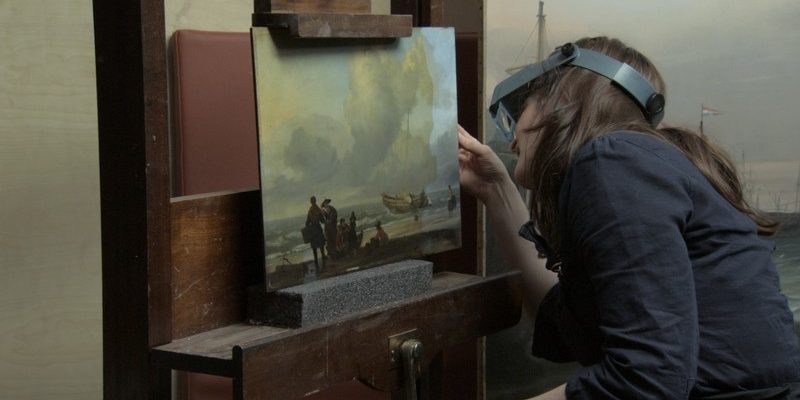The epic-length latest in a monumental career devoted to the study of public institutions, Frederick Wiseman’s National Gallery (2014; screening Sat., Dec. 13 at 4 & 8 p.m. and Sun., Dec. 14 at 2 p.m.) observes the life of the iconic London museum during one of its busiest seasons, a twelve week 2012 period that bridges blockbuster super-exhibition Leonardo da Vinci: Painter at the Court of Milan and its superstar successor Metamorphosis: Titan 2012, which the museum programmed during the Olympics (which the city was hosting that very summer). Bearing the, by now, very recognizable marks of the documentary master’s storytelling technique (National Gallery systematically avoids voice-over narration, title cards and on-screen graphics), Wiseman’s film seeks to capture the experience, or again what life is like in and around the museum. Though in keeping with the filmmaker’s ethos none of the action is staged or manipulated, National Gallery, by design, isn’t itself free of manipulation. Indeed, Wiseman’s latest, like 2010’s Boxing Gym, another OKCMOA Museum Films premiere, is a masterwork of rhythm, which this overwhelming UK institution itself dictates. We are made to feel this museum, not only to know it inside and out, which Wiseman’s work most certainly also achieves.
National Gallery, of course, is also a catalog, a list of the educational, curatorial, developmental, preservational and even maintenance activities that occur both for and amid the public, and also those that are, by design, hidden from view: Wiseman shows us outreach activities designed for blind patrons and for school groups; countless lectures that span the collection from Holbein to Velazquez to Stubbs; we are a fly-on-the-wall for contentious institutional meetings where curatorial and marketing staff debate the museum’s mission; we watch frames being made and 17th and 18th century masterpieces being carefully restored; we are present for an x-ray of a large Rembrandt canvas; and we even see the cleaning and instillation of the institution’s gallery. National Gallery is in this sense a substantial achievement of access and information (to and about one of the world’s most aspirational and envy-inspiring museums). It is also a work that is calculated to provide a sense of the great, Old Master-centric museum in its incredible and engaging totality, a wholeness that extends to such erudite in-gallery experiences as a ballet rehearsal in a darkened hall and a piano recital that suggest one of the greatest of all Anglo documentaries, Humphrey Jennings and Stewart McAllister’s deeply poetic Listen to Britain (1942). Much like Wiseman’s film itself, the museum is design to be an immersive, multi-sensory experience.
This fact also speaks to a principle anxiety voiced throughout the film: that it is necessary to make the museum’s Old Masters relevant to today’s viewers. Wiseman’s concluding set-piece may just have something to say about this, after all the passages of unique programming that provide National Gallery with its encyclopedic interest. Withholding physical human presence finally, though ironically providing us with more spiritual and emotional insight than in any other moment in this human-dominated film, Wiseman leaves us with the paintings alone, with a series of Rembrandt portraits that speak far more powerfully in silence. Captured above all in their anguished eyes and expressions, we are left with the infinity of each sitter.










